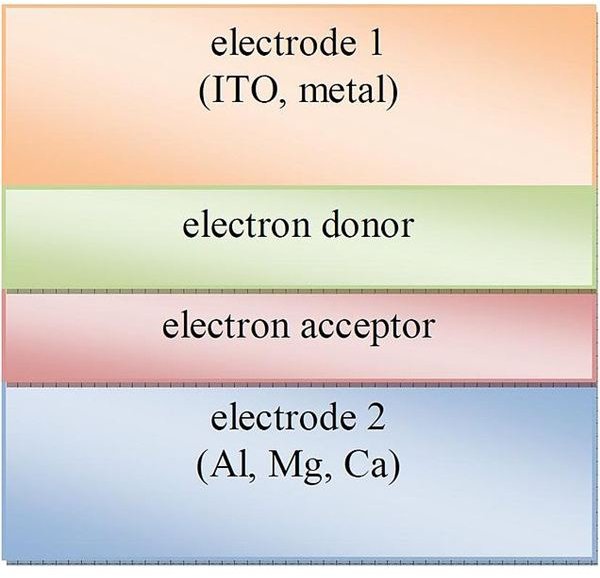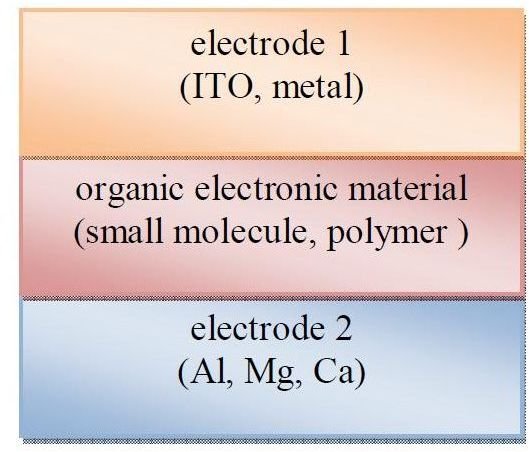Advantages of Organic Solar Cells
Organic Solar or Photovoltaic Cells (OPVs)
Organic or plastic solar cells use organic materials (carbon-compound based) mostly in the form of small molecules, dendrimers and polymers, to convert solar energy into electric energy. These semiconductive organic molecules have the ability to absorb light and induce the transport of electrical charges between the conduction band of the absorber to the conduction band of the acceptor molecule. There are various types of organic photovoltaic cells (OPVs), including single layered and multilayered structured cells. Both types are currently used in research and small area applications and both have their respective advantages and disadvantages.
The Structure of a Single-Layer & a Multilayer Organic Solar Cell

Advantages of Flexible Organic Compared to Rigid Conventional Solar Cells
The latest advances in molecular engineering have uncovered a series of organic cell potential advantages that may eventually outbalance the benefits of silicon based solar cells. Although conventional solar cells currently dominate the existing market, the case may be quite different in the near future.
Manufacturing Process & Cost
Organic solar cells can be easily manufactured compared to silicon based cells, and this is due to the molecular nature of the materials used. Molecules are easier to work with and can be used with thin film substrates that are 1,000 times thinner than silicon cells (order of a few hundred nanometers). This fact by itself can reduce the cost production significantly.
Since organic materials are highly compatible with a wide range of substrates, they present versatility in their production methods. These methods include solution processes (inks or paints), high throughput printing techniques, roll-to-roll technology and many more, that enable organic solar cells to cover large thin film surfaces easily and cost-effectively. All above methods have low energy and temperature demands compared to conventional semiconductive cells and can reduce cost by a factor of 10 or 20.
Tailoring Molecular Properties
An important advantage of organic materials used in solar cell manufacturing is the ability to tailor the molecule properties in order to fit the application. Molecular engineering can change the molecular mass, bandgap, and ability to generate charges, by modifying e.g. the length and functional group of polymers. Moreover, new unique formulations can be developed with the combination of organic and inorganic molecules, making possible to print the organic solar cells in any desirable pattern or color.
Desirable Properties
The tailoring of molecular properties and the versatility of production methods described on the previous page enable organic polymer solar cells to present a series of desirable properties. These solar modules are amazingly lighter and more flexible compared to their heavy and rigid counterparts, and thus less prone to damage and failure. They can exist in various portable forms (e.g. rolled form) and their flexibility makes storage, installation, and transport much easier.
Environmental Impact
The energy consumed to manufacture a solar cell is less than the amount required for conventional inorganic cells. Consequently, the energy conversion efficiency doesn’t have to be as high as the conventional cell’s efficiency. An extensive use of organic solar cells could contribute to the increased use of solar power globally and make renewable energy sources friendlier to the average consumer.
Multiple Uses and Applications
The present situation indicates that organic solar cells cannot substitute for silicon cells in the energy conversion field. However their use seems to be more targeted towards specific applications such as recharging surfaces for laptops, phones, clothes, and packages, or to supply the power for small portable devices, such as cellphones and MP3 players.
Other than the domestic use, recent developments have shown a military application potential for organic solar modules. Research in the US (Konarka) has shown that organic cells can be used in soldier tents to generate electricity and supply power to other military equipment such as night vision scopes and GPS (global positioning system) receivers. This technology is thought to be extremely valuable for demanding missions.
The Current Situation
Organic Solar cells have certain disadvantages including their low efficiency (only 5% efficiency compared to the 15% of silicon cells) and short lifetime. Nonetheless, their numerous benefits can justify the current international investment and research in developing new polymeric materials, new combinations, and structures to enhance efficiency and achieve low-cost and large-scale production within the next years. A commercially viable organic solar cell production is the target of the next decade.
Schematic Comparison of a Rigid Crystalline Silicon to a Flexible Organic Solar Cell

Sources:
- ScienceDaily: “Environmental Impact of Organic Solar Cells Assessed”
- ScienceDaily: “Renewable Energies: The Promise Of Organic Solar Cells”
- ScienceDaily:“Organic Solar Cells: Electricity From A Thin Film”
- Organic Solar Power, Institute of Science in Society
- Organic Solar Cells, D. Wohrle, D.Meissner, Advanced Materials
